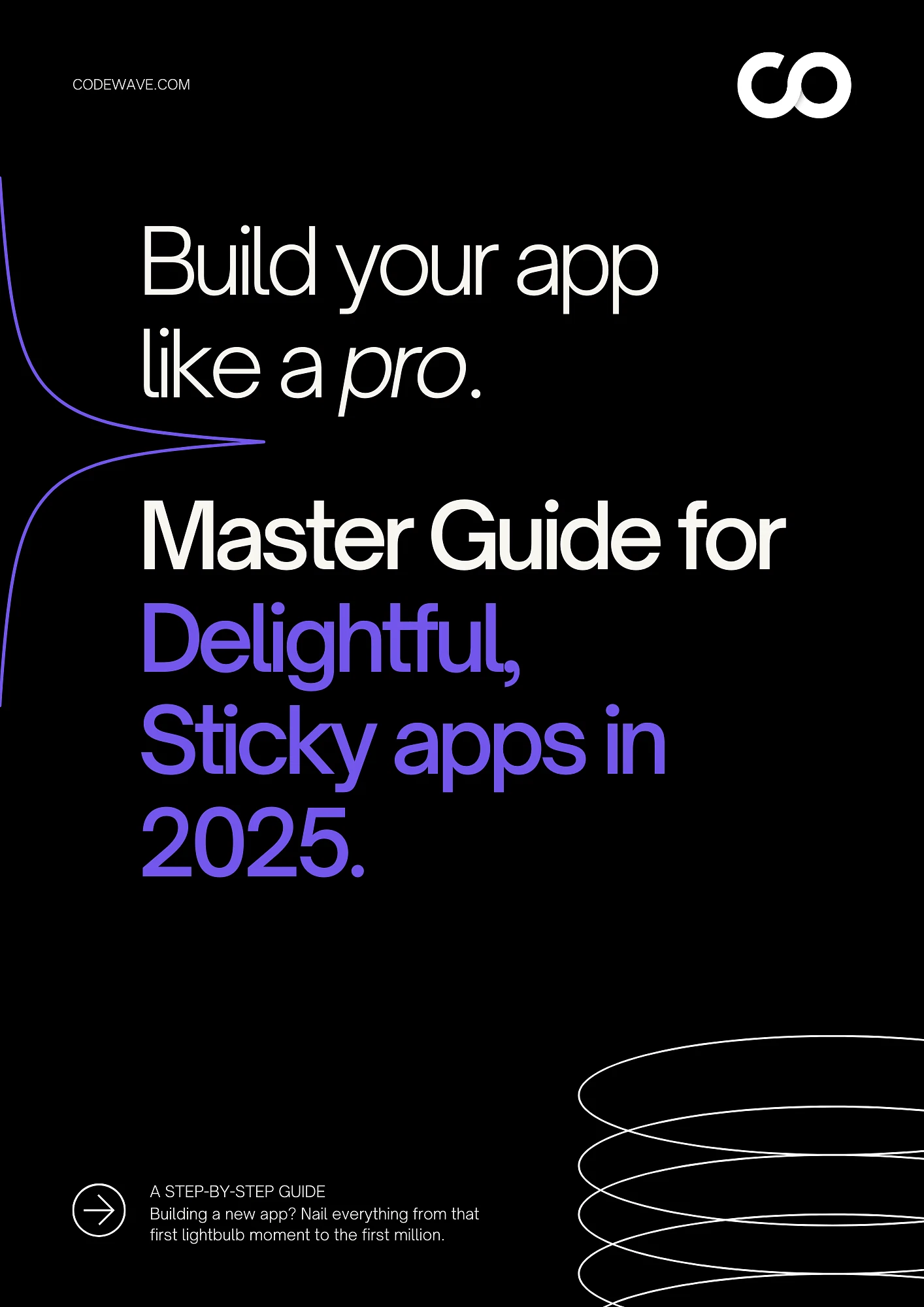Many businesses today are drawn to the allure of AI-powered tools that promise fast, low-cost prototypes orMVPs.
The temptation to skip traditional development processes in favor of these quick solutions is understandable, but what’s the hidden cost of such speed? Speed and cost are critical in the early stages of product development, but these elements can’t be the sole focus.
Real business value comes from solutions that are designed to scale, integrate seamlessly with existing systems, and evolve with the business. AI tools, despite their apparent affordability and speed, often fall short in these areas.
In fact, a report by McKinsey found that 70% of digital transformationsfail due to a lack of scalability, something AI-generated prototypes can’t always offer.
This blog explores why design thinking, with its focus on user-centric development and scalability, delivers more sustainable value compared to AI prototypes.
Key Takeaways
- AI Prototypes are ideal for early-stage validation, fast feedback, and low-cost MVP creation but fall short in scalability, customization, and long-term security.
- Design Thinking ensures long-term business success by focusing on user needs, scalability, integration, and a product’s ability to evolve over time.
- AI Prototypes lack the deep customization and security necessary for larger-scale products, especially as businesses grow and their needs become more complex.
- Custom Solutions built with design thinking are tailored, secure, and built for long-term ROI, with a focus on user experience and scalability.
- When your product needs growth, adaptability, and robust security, transitioning from AI prototypes to custom development is crucial.
What Is Design Thinking and Why Is It Crucial for Business Growth?
Design thinking is a human-centered approach to problem-solving that prioritizes understanding user needs, rapid prototyping, and continuous feedback. It’s essential for businesses because it ensures solutions are tailored to what customers truly value, leading to better user experiences, higher engagement, and long-term growth.
Key Principles of Design Thinking
Design thinking is built on key principles that help businesses create products that truly resonate with users. Here’s how these principles contribute to business success:
1. User-Centered Focus
Design thinking ensures products are created around real user pain points. This leads to solutions that are more likely to resonate with users, resulting in higher engagement and satisfaction. Research shows that businesses aligned with user needsexperience 1.5x better retention rates.
2. Rapid Prototyping and Testing
Instead of waiting for a perfect solution, design thinking encourages quick prototyping, allowing businesses to test concepts early, gather insights, and make adjustments quickly.
This iterative process reduces market failure risks by 60% by testingideas early, thereby avoiding expensive mistakes.
3. Iterative Process
Design thinking relies on continuous feedback loops, ensuring each product version is a refined improvement based on user insights.
Real-World Impact
By applying design thinking, businesses can drive measurable improvements in customer satisfaction and business outcomes. Here’s how it impacts real-world success:
- Improved Customer Retention: Products developed with design thinking are closely aligned with user expectations, driving higher customer loyalty. In fact, 90% of businesses across various industries report that customer experience (CX) has become their top priority.
- Faster Time to Market: By emphasizing iterative prototyping and feedback, product development is significantly accelerated. Businesses can introduce new products faster and refine them based on real-world use, allowing quicker entry into the market.
- Scalable Growth: Design thinking ensures that products are adaptable to changing user needs and market conditions. This flexibility fosters scalability, helping companies grow sustainably while continuously enhancing the user experience.
Also Read: A Step-By-Step Guide to Understanding the Process of Custom Software Development
How Are AI Prototypes Used? And What Are Their Limitations?
AI tools, such as AI-driven MVPsand prototyping platforms, are designed to help businesses quickly test ideas and validate concepts. These tools allow for fast, low-cost prototypes, which serve as a starting point for further development.
However, while AI prototypes can be effective for initial testing, they come with several limitations that can hinder their long-term success. Let’s dive into those limitations.
Limitations of AI Prototypes
Here’s a breakdown of the key limitations you need to consider when relying on AI prototypes for your business:
- Lack of Deep Personalization or Customization
AI prototypes typically rely on predefined templates and basic logic. This limits their ability to offer personalized experiences tailored to specific user needs.
Customization is crucial for businesses seeking to create unique solutions that cater to their audience, a need that AI prototypes often fail to address adequately.
- Limited Scalability and Failure to Address Complex User Needs
While AI prototypes may work well for small-scale projects or early-stage validation, they fail when handling large user bases or complex workflows.
For instance, an AI-generated landing page may suffice for a small campaign. Still, as user traffic and demand grow, these systems can become overwhelmed, struggling to handle complex processes or integrations.
- Security and Integration Gaps
AI prototypes often lack the security features necessary for modern applications. They tend to offer minimal control over data protection, compliance, and user privacy, areas that are critical for industries such as healthcare, finance, or e-commerce.
As a result, these prototypes may fail to meet essential security standards such as GDPR or HIPAA.
- Short Lifespan as Business Grows
AI prototypes are typically built for short-term goals like validation or basic functionality. However, as a business scales, its needs evolve, and these prototypes often cannot adapt.
Once the initial proof of concept is validated, the prototype becomes inadequate and requires significant redevelopment to meet growing demands.
Is your product truly solving user problems? At Codewave, we use Design Thinking to ensure your product aligns with real user needs and delivers measurable business value. From ideation to prototyping, we focus on iterative testing and feedback to optimize user engagement and product performance.
Now, let’s take a closer look at how custom solutions powered by design thinking compare to quick, AI-generated prototypes.
Why Design Thinking is the Better Investment: Custom Solutions vs. AI Prototypes
When businesses consider product development, the choice between AI prototypes and custom solutions based on design thinking often comes down to speed, cost, and long-term value.
Below is a detailed comparison that highlights the strategic advantages of custom solutions built with design thinking over AI prototypes.
| Feature | AI Prototypes | Custom Solutions |
| Speed to Market | Extremely fast; MVPs or demos can be built in hours/days | Takes weeks to months but delivers a fully tailored solution |
| Personalization | Limited to templates and pre-configured logic | Fully tailored to business goals, user needs, and workflows |
| Scalability | Limited; struggles with high traffic and complex flows | Built to scale, with proper infrastructure for growth |
| Security & Compliance | Basic, lacks enterprise-level security and compliance features | Full control over security measures, ensuring compliance with standards like GDPR, HIPAA, etc. |
| Integration Capability | Minimal integrations, requires significant rework for complex systems | Seamless integration with existing business systems (CRM, ERP, etc.) |
| Long-Term Value | Short-term value; requires redevelopment as business grows | Built for long-term ROI, supporting sustained growth and evolution |
| Customization | Rigid; limited ability to adapt templates for unique needs | High level of customization, aligning with specific business processes |
| Maintenance | High maintenance costs as the system grows and needs updates | Designed for maintainability, with scalability and flexibility in mind |
| User Experience (UX) | Basic and template-driven, resulting in generic user interfaces | Crafted for optimal user experience, ensuring engagement, conversion, and satisfaction |
Cost Comparison: AI Prototypes vs. Design Thinking
To better understand the trade-offs between AI prototypes and design thinking, here’s a detailed comparison that highlights key differences in the costs of the two :
| Factor | AI Prototypes | Custom Solutions |
| Upfront Cost | $1000 – $2,000 | $30,000+ for full custom development |
| Build Time | Hours to days | 4 to 16 weeks (depending on complexity) |
| Maintenance Costs | High as prototypes fail to scale | Lower long-term maintenance with CI/CD and optimization |
| Rebuild/Iteration Costs | Frequent rebuilds, scaling issues | Designed for scalability, minimizing rebuilds |
| Long-Term ROI | Low; needs frequent fixes and rework | High; scalable, secure, and reliable solutions |
Your business is unique, so should your software.
Let’s build a customized solution that fits your exact needs. At Codewave, we focus on building lean, high-impact software, emphasizing the 20% of features that drive 80% of the value. We offer custom-built solutions that transform your vision into a high-performing product with tangible business value.
Also Read: Building Practical LLM Apps: A Complete Guide
Now that we’ve explored the limits of AI prototypes, let’s discuss when it’s the right time to switch from AI tools to a full-fledged custom solution.
Can AI Tools Help Early-Stage Validation? Yes, But When Should You Switch?
AI tools offer significant advantages for early-stage validation, enabling businesses to quickly test ideas, gather feedback, and generate initial interest with minimal investment.
As businesses move forward, AI-driven conversational tools, such as chatbots and virtual agents, have seen tremendous growth. The conversational AI segment, projected to reach$13.9 billion by the end of this year, is fueled by the demand for 24/7 customer support, personalized interactions, and automated inquiries.
However, while AI tools are excellent for early validation, they can become limiting as a product scales. As businesses grow, the need for customization, deeper integration, and more robust systems becomes inevitable.
That’s when switching from AI prototypes to custom-built solutions is necessary to ensure the product’s adaptability, scalability, and long-term success.
Practical Example: From AI Prototypes to Custom Development
Here’s an example of how businesses can successfully transition from AI prototypes to custom-built products:
- AI Prototype Use Case
A startup uses AI-driven tools to build a landing page and test an idea for a new e-commerce platform. They use the prototype to gather feedback, run A/B tests, and validate the interest in their product.
After receiving positive user feedback and initial traction, the team realizes that the AI-generated prototype cannot scale or handle more advanced features, such as custom payment workflows or personalized recommendations.
- Transition to Custom Development
The startup transitions to a custom-built solution, focusing on scalability, seamless payment integrations, personalization, and security to support long-term growth, adaptability, and user experience at scale.
How Codewave Helps with Custom Design Thinking Solutions
At Codewave, we believe that every product should be crafted with purpose, user alignment, and long-term growth in mind.
Our custom design thinking solutions go beyond just development, they focus on understanding your target audience, refining user journeys, and continuously iterating based on honest feedback.
Key Services Offered by Codewave :
1. UX/UI Design & Prototyping:
We create intuitive, engaging, and user-centered designs that align with your brand, ensuring a seamless experience across all platforms.
2. Product Strategy & Roadmapping
We help define your product vision, prioritize features, and map out a clear strategy based on research and user feedback to ensure scalability and impact.
3. End-to-End Custom Web & Mobile Development
From concept to launch, we provide full-stack development, leveraging the latest technologies to build high-performance web and mobile apps with speed, scalability, and security.
4. Agile & Continuous Improvement
Our agile approach enables flexibility and continuous iteration, ensuring that your product evolves based on data and user feedback.
5. Full Product Lifecycle Support
We offer ongoing support, maintenance, and updates, keeping your product relevant and optimized as user needs and market conditions change.
6. Advanced Integrations
We integrate your product with CRMs, payment gateways, and third-party tools, ensuring seamless operation within your existing digital ecosystem.
7. Security & Compliance
We implement top-tier security practices and ensure compliance with industry standards like GDPR, HIPAA, and SOC 2, protecting user data and meeting regulatory requirements.
8. AI and Automation Integration
We integrate AI and automation features like predictive analytics and personalized recommendations, enhancing user experience and operational efficiency.
Codewave’s custom design thinking approach has delivered success for businesses across industries. Explore our portfolioto see how we’ve helped companies create scalable, impactful products.
Conclusion
When deciding between AI prototypes and custom design thinking solutions, it’s crucial to weigh the long-term needs of your business. AI prototypes are ideal for early-stage testing, rapid feedback, and quickly validating concepts, especially when budgets are tight or speed is paramount.
However, as your product scales and requires deeper personalization, complex integrations, and robust security, transitioning to a custom-built solution becomes essential.
Why Choose Codewave for Custom Design Thinking?
With over 400 successful projects across 15+ industries, Codewaveis a trusted partner in custom web and mobile development. We design products that meet user needs and drive business growth, ensuring scalability, flexibility, and rapid delivery.
Here’s why businesses trust Codewave:
- User-Centric Design: We focus on creating intuitive experiences that drive engagement and satisfaction.
- Scalable Solutions: Our products grow with your business, adapting as needs evolve.
- Quick, Reliable Delivery: We ensure timely delivery without compromising quality.
- Seamless Collaboration: We keep you in the loop from ideation to launch.
- Proven Expertise: Our experience across industries guarantees successful outcomes.
Ready to turn your ideas into impactful products?Contact Codewave today, and let’s get started.
FAQs
Q: How does design thinking ensure better user engagement?
A: Design thinking ensures that the product is built around real user pain points and needs. By prioritizing user experience and continuous feedback, it helps create intuitive and engaging interfaces that drive higher adoption and customer retention.
Q: Can AI prototypes handle complex workflows and integrations?
A: AI prototypes typically lack the capability to handle complex workflows and integrations with other systems like CRMs or payment gateways. They are designed for simplicity, which becomes a limitation as the business expands and requires more sophisticated features.
Q: What are the long-term risks of relying on AI prototypes for growth?
A: AI prototypes often require constant redevelopment as the business grows. They fail to scale with increasing traffic, handle advanced security requirements, or adapt to changing business needs, leading to higher costs and potential service disruptions in the long run.
Q: How does transitioning to custom software improve security?
A: Custom software solutions incorporate enterprise-grade security measures, including encryption, access control, and compliance with industry standards like GDPR and HIPAA. These features are tailored to the specific needs of the business, ensuring that sensitive data is protected.
Q: What role does user feedback play in the custom design process?
A: In custom design, user feedback is continuously incorporated through iterative prototyping and testing. This ensures that the product evolves based on actual user needs, leading to a more refined, effective, and user-centered solution that drives better outcomes.
Codewave is a UX first design thinking & digital transformation services company, designing & engineering innovative mobile apps, cloud, & edge solutions.







